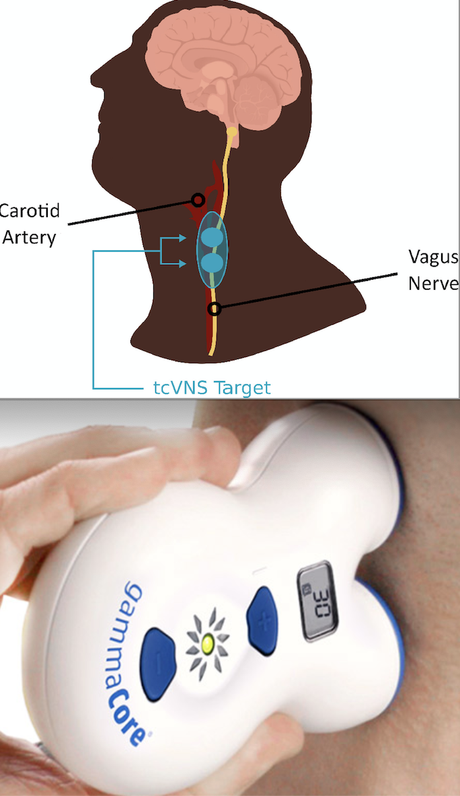I want to point to an article by Caron that reviews work investigating therapeutic effects of stimulating our vagus nerve, two large nerve fiber bundles that run down both sides of our neck from the brain stem to our internal organs to regulate our parasympathetic 'calming' nervous system (as distinguished from the 'arousing' sympathetic part of our autonomic nervous system.) In the work by Bremmer et al. (open source) cited by Caron I was struck by the simplicity and accessibility of the simple technique used to stimulate the neck vagus nerves and suppress inflammatory and stress responses.

For technically inclined readers like myself, I pass on the following details of the vagal stimulation:Figure 3. Diagram showing placement of tcVNS device on the neck to target the vagus nerve as it travels through the carotid sheath.
Both active tcVNS and sham stimuli were administered using hand-held devices that target the cervical portion of the vagus nerve from the skin (GammaCore, ElectroCore, Basking Ridge, New Jersey). Stimulation was applied using collar, stainless steel electrodes with a conductive electrode gel placed on the left side of the neck over the carotid sheath as determined by palpation of the carotid artery (Figure 3). Active tcVNS devices produced an alternating voltage signal consisting of five 5kHz sine bursts (1 ms of five sine waves with pulse width of 40 ms) repeating at a rate of 25 Hz envelopes. The frequency of 25 Hz was chosen based on prior studies showing optimization of effects on autonomic function and other measures at this frequency...The sham devices produce an alternating biphasic voltage signal consisting of 0.2 Hz square pulses (pulse width of 5 s) eliciting a mild sensation...Both active and sham devices delivered two minutes of stimulation. The stimulation intensity (amplitude of the voltage wavefront) was adjustable using a roll switch that ranged from 0 to 5 a.u. (arbitrary units) with a corresponding peak output ranging from 0 to 30V for active tcVNS, and from 0 to 14 V for the sham device. During each application, the amplitude of the voltage waveform was increased to the maximum the subject could tolerate, without pain. The stimulation continued at the selected intensity...The rationale behind the frequency difference between active (5kHz) and sham (0.2Hz) device waveforms is based on the fact that high frequency voltage signals (such as the active stimulus, 5kHz) pass through the skin with minimal power dissipation due to the low skin-electrode impedance at kHz frequencies. In contrast, lower frequency signals (such as the sham stimulus, 0.2Hz) are mainly attenuated at the skin-electrode interface due to the high impedance (Rosell et al., 1988). Accordingly, the active device operating at higher frequencies can deliver substantial energy to the vagus nerve to facilitate stimulation, while the voltage levels appearing at the vagus would be expected to be orders of magnitude lower for the sham device and thus stimulation is unlikely. Nevertheless, since the sham device does deliver relatively high voltage levels directly to the skin, it activates skin nociceptors, causing a similar feeling to a pinch. This sensation is considered to be necessary for blinding of the participants, particularly longitudinal protocols such as in this manuscript.

